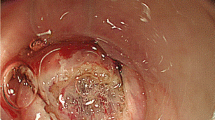Abstract
Purpose
Transanal endoscopic microsurgery (TEM) and endoscopic submucosal dissection (ESD) are currently the two most popular methods for resecting large rectal adenomas en bloc. However, damage to the mesorectum in the case of TEM, plus the technical challenges and long procedure times of flexible ESD, are major disadvantages of these procedures. Transanal endoscopic microsurgical submucosal dissection (TEM-ESD) is a new technique, combining the ergonomic features of TEM with the minimally invasive approach of ESD. The aim of our study was to assess the feasibility and safety of TEM-ESD for resection of large rectal adenomas.
Methods
We retrospectively analyzed all TEM-ESD procedures performed in Karlsruhe Municipal Hospital between 2012 and 2019, isolated all cases of adenomas, and analyzed the perioperative and follow-up data of the patients.
Results
We identified 145 cases matching our criteria. The median size of the lesions was 4.2 cm, and the median operating time was 45 min. The en bloc resection rate was 100%, and the complete en bloc resection rate was 78.6%. The overall morbidity rate was 6.9%. In a median follow-up period of 24 months, there was a local recurrence in 4.8% of the cases.
Conclusions
TEM-ESD is a safe and feasible therapeutic option for resecting large rectal adenomas, offering high en bloc resection and low recurrence rates combined with short operating time and low morbidity.
Trial Registration Number (ClinicalTrials.gov)
NCT04870931.

Similar content being viewed by others
Data availability
The data and material were collected upon special request and after the approval of the local ethics committee was granted.
References
KazemShahmoradi M, Soleimaninejad M, Sharifian M (2020) Evaluation of colonoscopy data for colorectal polyps and associated histopathological findings. Ann Med Surg 57:7–10. https://doi.org/10.1016/j.amsu.2020.07.010
de Ceglie A, Hassan C, Mangiavillano B et al (2016) Endoscopic mucosal resection and endoscopic submucosal dissection for colorectal lesions: a systematic review. Crit Rev Oncol Hematol 104:138–155
Denzer U, Beilenhoff U, Eickhoff A et al (2016) S2k-Leitlinie Qualitätsanforderungen in der gastrointestinalen Endoskopie, AWMF Register Nr. 021–022. Z Gastroenterol 53:E1–E227. https://doi.org/10.1055/s-0041-109598
Buess G, Theiss R, Gunther M et al (1985) Endoscopic surgery in the rectum. Endoscopy 17:31–35. https://doi.org/10.1055/s-2007-1018451
Casadesus D (2009) Surgical resection of rectal adenoma: a rapid review. World J Gastroenterol 15:3851–3854
Allaix ME, Arezzo A, Arolfo S et al (2013) Transanal endoscopic microsurgery for rectal neoplasms. How i do it. J Gastrointest Surg 17:586–592. https://doi.org/10.1007/s11605-012-2060-x
Gavagan JA, Whiteford MH, Swanstrom LL (2004) Full-thickness intraperitoneal excision by transanal endoscopic microsurgery does not increase short-term complications. Am J Surg 187(5):630–634. https://doi.org/10.1016/j.amjsurg.2004.01.004
Morino M, Allaix ME, Famiglietti F et al (2013) Does peritoneal perforation affect short- and long-term outcomes after transanal endoscopic microsurgery? Surg Endosc 27:181–188. https://doi.org/10.1007/s00464-012-2418-x
Guerrieri M, Gesuita R, Ghiselli R et al (2014) Treatment of rectal cancer by transanal endoscopic microsurgery: experience with 425 patients. World J Gastroenterol 20:9556–9563. https://doi.org/10.3748/wjg.v20.i28.9556
Tanaka S, Oka S, Kaneko I et al (2007) Endoscopic submucosal dissection for colorectal neoplasia: possibility of standardization. Gastrointest Endosc 66:100–107. https://doi.org/10.1016/j.gie.2007.02.032
Saito Y, Sakamoto T, Fukunaga S et al (2009) Endoscopic submucosal dissection (ESD) for colorectal tumors. Dig Endosc 21(Suppl 1):S7–S12. https://doi.org/10.1111/j.1443-1661.2009.00870.x
Fujishiro M, Yahagi N, Kakushima N et al (2007) Outcomes of endoscopic submucosal dissection for colorectal epithelial neoplasms in 200 consecutive cases. Clin Gastroenterol Hepatol 5:678–683. https://doi.org/10.1016/j.cgh.2007.01.006
Wagner A, Neureiter D, Kiesslich T et al (2018) Single-center implementation of endoscopic submucosal dissection (ESD) in the colorectum: low recurrence rate after intention-to-treat ESD. Dig Endosc 30:354–363. https://doi.org/10.1111/den.12995
Baral J (2018) Transanal endoscopic microsurgical submucosa dissection in the treatment of rectal adenomas and T1 rectal cancer. Coloproctology 40:364–372
Schmiegel W, Buchberger B, Follmann M et al (2017) S3-Leitlinie – Kolorektales Karzinom. Z Gastroenterol 55(12):1344–1498. https://doi.org/10.1055/s-0043-121106
Agha R, Abdall-Razak A, Crossley E et al (2019) STROCSS 2019 guideline: strengthening the reporting of cohort studies in surgery. Int J Surg 72:156–165. https://doi.org/10.1016/j.ijsu.2019.11.002
Kouladouros K, Baral J (2021) Transanal endoscopic microsurgical submucosal dissection (TEM-ESD): a novel approach to the local treatment of early rectal cancer. Surg Oncol 39:101662. https://doi.org/10.1016/J.SURONC.2021.101662
Dindo D, Demartines N, Clavien P-A (2004) Classification of surgical complications. Ann Surg 240:205–213. https://doi.org/10.1097/01.sla.0000133083.54934.ae
Saclarides TJ, Smith L, Ko ST et al (1992) Transanal endoscopic microsurgery. Dis Colon Rectum 35:1183–1191. https://doi.org/10.1007/BF02251975
Lartigau C, Lebreton G, Alves A (2013) Local resection for small rectal cancer. J Visc Surg 150:325–331
Probst A, Ebigbo A, Märkl B et al (2017) Endoscopic submucosal dissection for early rectal neoplasia: experience from a European center. Endoscopy 49:222–232. https://doi.org/10.1055/s-0042-118449
Probst A, Ebigbo A, Märkl B et al (2018) Endoscopic submucosal dissection for rectal neoplasia extending to the dentate line: European experience. Endosc Int Open 06:E1355–E1362. https://doi.org/10.1055/a-0749-8735
Kouladouros K, Warkentin V, Kähler G (2021) Transanal endoscopic microsurgical submucosal dissection: are there advantages over conventional ESD? Minim Invasive Ther Allied Technol. https://doi.org/10.1080/13645706.2021.1967999
Guerrieri M, Baldarelli M, Morino M et al (2006) Transanal endoscopic microsurgery in rectal adenomas: experience of six Italian centres. Dig Liver Dis 38:202–207. https://doi.org/10.1016/j.dld.2005.11.014
Hahnloser D, Cantero R, Salgado G et al (2015) Transanal minimal invasive surgery for rectal lesions: should the defect be closed? Colorectal Dis 17:397–402. https://doi.org/10.1111/codi.12866
Ogasawara N, Yoshimine T, Noda H et al (2016) Clinical risk factors for delayed bleeding after endoscopic submucosal dissection for colorectal tumors in Japanese patients. Eur J Gastroenterol Hepatol 28:1407–1414. https://doi.org/10.1097/MEG.0000000000000723
Jung DH, Youn YH, Kim JH, Park H (2015) Endoscopic submucosal dissection for colorectal lateral spreading tumors larger than 10 cm: is it feasible? Gastrointest Endosc 81:614–620. https://doi.org/10.1016/j.gie.2014.09.001
Khoury R, Duek SD, Issa N, Khoury W (2016) Transanal endoscopic microsurgery for large benign rectal tumors; where are the limits? Int J Surg 29:128–131. https://doi.org/10.1016/j.ijsu.2016.03.041
van den Boezem PB, Kruyt PM, Stommel MWJ et al (2012) Transanal single-port surgery for the resection of large polyps. Dig Surg 28:412–416. https://doi.org/10.1159/000334882
Saclarides TJ (2007) TEM/local excision: indications, techniques, outcomes, and the future. J Surg Oncol 96:644–650
Repici A, Hassan C, Pagano N et al (2013) High efficacy of endoscopic submucosal dissection for rectal laterally spreading tumors larger than 3 cm. Gastrointest Endosc 77:96–101. https://doi.org/10.1016/j.gie.2012.08.036
Emmanuel A, Gulati S, Burt M et al (2018) Using endoscopic submucosal dissection as a routine component of the standard treatment strategy for large and complex colorectal lesions in a western tertiary referral unit. Dis Colon Rectum 61:743–750. https://doi.org/10.1097/DCR.0000000000001081
Guerrieri M, Baldarelli M, Rimini M et al (2013) Microchirurgia endoscopica transanale per i tumori rettali: Un’alternativa alia chirurgia radicale? Minerva Chir 68:289–298
Ramirez JM, Aguilella V, Gracia JA et al (2009) Local full-thickness excision as first line treatment for sessile rectal adenomas: long-term results. Ann Surg 249:225–228. https://doi.org/10.1097/SLA.0b013e318190496f
Saito Y, Kawano H, Takeuchi Y et al (2012) Current status of colorectal endoscopic submucosal dissection in Japan and other Asian countries: progressing towards technical standardization. Dig Endosc 24:67–72. https://doi.org/10.1111/j.1443-1661.2012.01282.x
Chan T, Karimuddin AA, Raval MJ et al (2020) Predictors of rectal adenoma recurrence following transanal endoscopic surgery: a retrospective cohort study. Surg Endosc 34:3398–3407. https://doi.org/10.1007/s00464-019-07114-0
Lee EJ, Lee JB, Lee SH et al (2013) Endoscopic submucosal dissection for colorectal tumors - 1,000 colorectal ESD cases: one specialized institute’s experiences. Surg Endosc 27:31–39. https://doi.org/10.1007/s00464-012-2403-4
Kumar AS, Coralic J, Kelleher DC et al (2013) Complications of transanal endoscopic microsurgery are rare and minor: a single institution’s analysis and comparison to existing data. Dis Colon Rectum 56:295–300. https://doi.org/10.1097/DCR.0b013e31827163f7
Molina G, Bordeianou L, Shellito P, Sylla P (2016) Transanal endoscopic resection with peritoneal entry: a word of caution. Surg Endosc 30:1816–1825. https://doi.org/10.1007/s00464-015-4452-y
Mege D, Petrucciani N, Maggiori L, Panis Y (2017) Peritoneal perforation is less a complication than an expected event during transanal endoscopic microsurgery: experience from 194 consecutive cases. Tech Coloproctol 21:729–736. https://doi.org/10.1007/s10151-017-1676-y
Issa N, Fenig Y, Yasin M et al (2016) Laparoscopy following peritoneal entry during transanal endoscopic microsurgery may increase the safety and maximize the benefits of the transanal excision. Tech Coloproctol 20:221–226. https://doi.org/10.1007/s10151-016-1436-4
Barker JA, Hill J (2011) Incidence, treatment and outcome of rectal stenosis following transanal endoscopic microsurgery. Tech Coloproctol 15:281–284. https://doi.org/10.1007/s10151-011-0703-7
Abe S, Sakamoto T, Takamaru H et al (2016) Stenosis rates after endoscopic submucosal dissection of large rectal tumors involving greater than three quarters of the luminal circumference. Surg Endosc 30:5459–5464. https://doi.org/10.1007/s00464-016-4906-x
Ohara Y, Toyonaga T, Tanaka S et al (2016) Risk of stricture after endoscopic submucosal dissection for large rectal neoplasms. Endoscopy 48:62–70. https://doi.org/10.1055/s-0034-1392514
Arezzo A, Passera R, Saito Y et al (2014) Systematic review and meta-analysis of endoscopic submucosal dissection versus transanal endoscopic microsurgery for large noninvasive rectal lesions. Surg Endosc 28:427–438
Fujishiro M, Yahagi N, Nakamura M et al (2006) Endoscopic submucosal dissection for rectal epithelial neoplasia. Endoscopy 38:493–497. https://doi.org/10.1055/s-2006-925398
Niimi K, Fujishiro M, Kodashima S et al (2010) Long-term outcomes of endoscopic submucosal dissection for colorectal epithelial neoplasms. Endoscopy 42:723–729. https://doi.org/10.1055/s-0030-1255675
Kneist W, Terzic A, Burghardt J et al (2004) Selektion von patienten mit rektumtumoren zur lokalen exzision aufgrund der präoperativen diagnostik: Ergebnisse einer konsekutiven erfassungsstudie von 552 patienten. Chirurg 75:168–175. https://doi.org/10.1007/s00104-003-0746-z
Baatrup G, Elbrønd H, Hesselfeldt P et al (2007) Rectal adenocarcinoma and transanal endoscopic microsurgery. Diagnostic challenges, indications and short term results in 142 consecutive patients. Int J Colorectal Dis 22:1347–1352. https://doi.org/10.1007/s00384-007-0358-z
Buess G, Mentges B, Manncke K et al (1992) Technique and results of transanal endoscopic microsurgery in early rectal cancer. Am J Surg 163:63–70. https://doi.org/10.1016/0002-9610(92)90254-O
Author information
Authors and Affiliations
Contributions
Both authors contributed equally to the conception of the study and the data analysis. J. Baral first described the technique studied and performed most of the resections. K. Kouladouros wrote the manuscript. Both authors revised and approved the manuscript.
Corresponding author
Ethics declarations
Ethics statement/consent to participate
Approval from the local ethics committee (University of Heidelberg) was acquired (Approval Number 2021–801). All the data were pseudonymized and retrospectively analyzed, so no informed consent was necessary according to the ethics committee.
Competing interests
Jörg Baral declares that he has a consulting contract with Richard Wolf GmbH, Knittlingen, Germany. Konstantinos Kouladouros has none to declare.
Additional information
Publisher’s note
Springer Nature remains neutral with regard to jurisdictional claims in published maps and institutional affiliations.
Rights and permissions
About this article
Cite this article
Kouladouros, K., Baral, J. Transanal endoscopic microsurgical submucosal dissection (TEM-ESD) for rectal adenomas: a retrospective cohort study of 145 consecutive cases. Langenbecks Arch Surg 407, 2423–2430 (2022). https://doi.org/10.1007/s00423-022-02562-0
Received:
Accepted:
Published:
Issue Date:
DOI: https://doi.org/10.1007/s00423-022-02562-0




